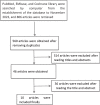The residual rate of HPV and the recurrence rate of CIN after LEEP with negative margins: A meta-analysis
- PMID: 38484015
- PMCID: PMC10939204
- DOI: 10.1371/journal.pone.0298520
The residual rate of HPV and the recurrence rate of CIN after LEEP with negative margins: A meta-analysis
Abstract
Background: HPV is detected in up to 47% of CIN and up to 70% of cervical cancers. It can cause intraepithelial neoplasia, which can eventually progress to invasive carcinoma. Almost all cervical cancers are caused by HPV. Therefore, it is especially important to treat high-risk HPV. For patients who have undergone LEEP surgery, this procedure can effectively treat CIN. However, it has not been studied in a meta-analysis whether HPV remains after the surgery and whether residual HPV increases the recurrence risk of CIN. To address this gap, our study collected all relevant literature to investigate the residual rate of HPV and its potential influence on the recurrence rate of CIN. We aim to provide valuable recommendations for clinicians and patients.
Methods: The Cochrane Library, EMBASE, and PubMed databases were searched from the establishment of the database until October 2023. Stata 12.0 software was used for the statistical analysis.
Results: Twelve studies were included, with a total sample size of 1192 cases. The meta-analysis found that the recurrence rate of CIN was quite low [95% CI = 0.5% (0.001, 0.012); P = 0.006] when the margins were negative after LEEP and there was no residual HPV. When HPV was present, the recurrence rate of CIN was significantly higher [95% CI = 18% (0.089, 0.291), P = 0.000], even if the margins were negative. The recurrence rate of CIN with residual HPV was 3.6 times higher than the recurrence rate of CIN without residual HPV. The residual rate of HPV after LEEP with negative margins was 22.7% [95% CI (0.167, 0.294), P = 0.000], which remained relatively high.
Conclusion: This meta-analysis found that the recurrence rate of CIN without residual HPV and with negative margins after LEEP was quite low, at 0.5%. However, when HPV was residual, the recurrence rate of CIN significantly increased to 18%, even if the margins were negative. The residual rate of HPV was 22.7%, even when the margins were negative after LEEP.
Copyright: © 2024 Lin et al. This is an open access article distributed under the terms of the Creative Commons Attribution License, which permits unrestricted use, distribution, and reproduction in any medium, provided the original author and source are credited.
Conflict of interest statement
The authors have declared that no competing interests exist.
Figures




Similar articles
-
Residual and recurrent disease rates following LEEP treatment in high-grade cervical intraepithelial lesions.Arch Gynecol Obstet. 2010 Jul;282(1):69-73. doi: 10.1007/s00404-009-1298-3. Epub 2009 Nov 26. Arch Gynecol Obstet. 2010. PMID: 19940997
-
Prediction of residual/recurrent disease by HPV genotype after loop excision procedure for high-grade cervical intraepithelial neoplasia with negative margins.Aust N Z J Obstet Gynaecol. 2011 Apr;51(2):114-8. doi: 10.1111/j.1479-828X.2010.01280.x. Epub 2011 Jan 31. Aust N Z J Obstet Gynaecol. 2011. PMID: 21466511
-
Assessment of cervical intraepithelial neoplasia (CIN) with colposcopic biopsy and efficacy of loop electrosurgical excision procedure (LEEP).Arch Gynecol Obstet. 2012 Dec;286(6):1549-54. doi: 10.1007/s00404-012-2493-1. Epub 2012 Aug 3. Arch Gynecol Obstet. 2012. PMID: 22865036
-
Adjuvant Human Papillomavirus Vaccine to Reduce Recurrent Cervical Dysplasia in Unvaccinated Women: A Systematic Review and Meta-analysis.Obstet Gynecol. 2020 May;135(5):1070-1083. doi: 10.1097/AOG.0000000000003833. Obstet Gynecol. 2020. PMID: 32282601
-
Epidemiology of cervical intraepithelial neoplasia: the role of human papillomavirus.Baillieres Clin Obstet Gynaecol. 1995 Mar;9(1):1-37. doi: 10.1016/s0950-3552(05)80357-8. Baillieres Clin Obstet Gynaecol. 1995. PMID: 7600720 Review.
Cited by
-
Factors associated with CIN2-3 recurrence: A single center retrospective analysis.Hum Vaccin Immunother. 2025 Dec;21(1):2469410. doi: 10.1080/21645515.2025.2469410. Epub 2025 Feb 21. Hum Vaccin Immunother. 2025. PMID: 39982437 Free PMC article.
References
-
- Winer RL, Hughes JP, Feng Q, O’Reilly S, Kiviat NB, Holmes KK, et al.. Condom use and the risk of genital human papillomavirus infection in young women[J]. N Engl J Med. 2006;354:2645–2654. - PubMed
-
- de Martel C, Ferlay J, Franceschi S, Vignat J, Bray F, Forman D, et al.. Global burden of cancers attributable to infections in 2008: a review and synthetic analysis[J]. Lancet Oncol. 2012;13:607–615. - PubMed
-
- Chaturvedi AK. Beyond cervical cancer: burden of other HPV-related cancers among men and women[J]. J Adolesc Health. 2010;46:S20–S26. - PubMed
-
- Tota JE, Chevarie-Davis M, Richardson LA, Devries M, Franco EL. Epidemiology and burden of HPV infection and related diseases: implications for prevention strategies[J]. Prev Med. 2011;(53 Suppl 1):S12–S21. - PubMed

